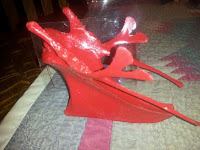Timothy Byler, DRE
©️2022 Dr. Timothy Byler - All Rights Reserved
When I was in the fourth grade, I had a wonderful “grandmotherly” Sunday school teacher. Mary Henderson (affectionately, Aunt Mary) was a practical, common sense lady who had experienced childhood during the Great Depression. She had lived her life in a hands on, “waste not want not”, Amish Mennonite influenced, community in Lancaster County, Pennsylvania.
More than one who taught Bible stories and lessons, she worked to teach those principles in a way that her young students could apply those values to every day life, and equally important, how to view life through a lens that would teach us how to find value in ways that others would too often miss.
One Friday after Thanksgiving, Aunt Mary brought her Sunday School class to her home for the day. After eating lunch together, she made certain that we carefully washed our hands, sat us at the kitchen table, and placed in front of us two turkey carcasses - the remnants of the Thanksgiving feast she had prepared and served the day before. She had placed them into stock pots and boiled them down earlier that morning.
“Is there anything valuable in these bones?” she asked.
We discussed and determined that there was no real value. The bones were too soft to give to the dogs. They weren’t good for compost. There was the upside of the “wishbone” but there was only two of those, and those wishes had already been cast.
Aunt Mary put us to work, telling us to “separate the meat from the bones.” It took us about thirty minutes to pull the pieces apart and separate the remaining morsels of meat from the skin, the fat, and the bones. When we were finished to her satisfaction, she weighed the meat and showed us that we had pulled two pounds of meat from those two carcasses.
Next, she took us to the stove and opened the two stock pots she had used to boil the carcasses. She had more than a gallon of “stock” - the delicious broth that carried all of the rich flavors of the turkey as it had been roasted, covered with herbs and spices.
As we were working, Aunt Mary had been working along side of us. She talked about how life had good parts and parts that didn’t look so good. Some parts were like delicious meat and gravy. Others were like a carcass that was only for for buzzards. Life was like those turkeys - full of good things but also seemingly full of greasy, bony things - like the mess that was leftover after the good parts had been taken. And, she taught us that when everything looks like a mess, there is still a lot of good to be found if you were willing to look hard enough to find it.
She taught us that when we heard things said or even experienced the actions of others, that instead of running from it or casting it aside, we should learn how
to separate the meat from the bones.
Aunt Mary led us back to the table and we began cutting up vegetables - potatoes, celery, carrots, and onions. She had us separate the vegetables and the meat into equal portions and drop the portions into the two stock pots to make soup. One of the girls said, “Don’t we need to add salt?” Aunt Mary replied, “No sweetie. This soup was seasoned as the turkey was cooking yesterday. Often, our life is seasoned by what we experience. It is why God taught us to be salt and light.”
We cleaned up from our cooking and spent the afternoon playing games, and when dinnertime came we sat down to some of the best turkey soup we had ever tasted.
Aunt Mary asked us, “Was there anything valuable found in those bones?” We heartily agreed.
As we were eating, Aunt Mary went to the counter and came back with two bones - the breast bones. She said, “I have something else to show you. These are special. They cannot be used right away. They need to be cleaned and dried. But, I want to show you how to find even more value.” She went into the other room and when she came back, she was carrying a little statue of Reindeer and a sleigh.
She said, “This was made from the bones of last year’s turkey.” As we looked, we recognized that the sleigh was actually the breast bone of the turkey. She had dried it and painted it and made a Christmas decoration from it.
The moral was simple, and caught by a group of fourth graders. There is good to be found if you are willing to separate and use the good parts and discard the bad. But, there is another moral to be found.
As an adult, I have boiled down a lot of turkey carcasses. Some of my friends - especially some of my fellow coaches have ribbed (yeah the pun is intended) me about this practice.
“What a waste of time - digging around for that extra pound of meat.
Your time is more valuable than that.”
“Aren’t you past the stage when you have to be THAT frugal? You’re acting like someone who has to “pick the bones” rather than someone who has achieved your level of success. You should be thinking LARGER. You are past the time when you need to
get your hands messy with that stuff.”
They miss the point of the real hidden value. There’s a flavor to he found in the soup that will not be found any other way. My pulling apart that carcass was at one time in my life, a labor of necessity. Now, it is a labor of joy. It reminds me of where I came from, the lessons I have learned, and that I do this now because I WANT to rather than because I HAVE to. And…when my family sits down to that soup - or gumbo this time - the joy they experience will be seasoned by the love and life lessons I learned at Aunt Mary’s table.
The time wasn’t wasted. It was time well well spent - for as I separated the meat from the bones today, I wrote this story in my head. And, maybe - just maybe - it will encourage you the reader to take a little time to look for the meat in the bony areas of your life.
Happy Thanksgiving!
(Photos of the meat are mine from today. Photos of the sleigh were from the web to show you an example of what Aunt Mary made. Her, my mother, and a number of ladies in the church made these during those years.)



